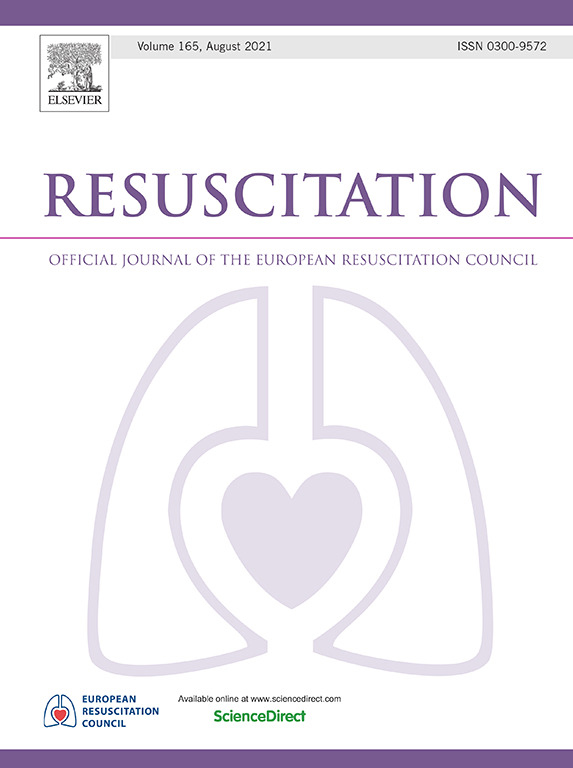Assessing both early and late EEG patterns improves prediction of outcome after cardiac arrest
IF 4.6
1区 医学
Q1 CRITICAL CARE MEDICINE
引用次数: 0
Abstract
Objective
Previously proposed “synchronous EEG patterns” predict poor outcome within 24 h after cardiac arrest (CA). We investigate the prognostic performance of these early EEG predictors in addition to the late EEG predictors (>24 h) recommended in the European post-resuscitation guidelines.
Methods
Observational substudy of the TTM2-trial including consecutive comatose resuscitated patients. Continuous EEG-monitoring (cEEG) was blindly assessed using the American Clinical Neurophysiology Societýs standardised EEG terminology and categorised into early EEG predictors (burst-suppression with identical or highly epileptiform bursts, or suppression with generalised periodic discharges) and late EEG predictors (heterogenous burst-suppression or suppression). Poor outcome was defined as modified Rankin Scale 4–6 at six months.
Results
Of 191 included patients, 53 % had poor outcome. Early EEG predictors had 100 %[CI 96–100] specificity at all time-points and maximal sensitivity 30 %[CI 21–40] before 24 h. Late EEG predictors had 100 %[CI 96–100] specificity beyond 24 h with maximal sensitivity 32 %[CI 21–43]. Using both early and late EEG predictors, and gradually adding cEEG-information from consecutive time-epochs, sensitivity increased to 49 %[CI 39–59] up to 36 h after CA (p = 0.001). A continuous background within 12 h predicted good outcome (sensitivity 61 %[CI 50–71]; specificity 87 %[CI 79–93]).
Conclusion
Searching for both early EEG predictors (e.g. identical burst-suppression) and late EEG predictors (e.g. heterogenous burst-suppression > 24 h) significantly improved sensitivity of poor outcome prediction without false positive survivors in this cohort. A self-fulfilling prophecy may have affected our results. cEEG during the first two days after CA identified half of the patients with a long-term poor outcome and half of the patients with a good outcome.
评估早期和晚期脑电图模式有助于心脏骤停后预后的预测。
目的:先前提出的“同步脑电图模式”预测心脏骤停(CA)后24小时内的不良预后。我们研究了这些早期脑电图预测指标以及欧洲复苏后指南中推荐的晚期脑电图预测指标(bb0 24h)的预后表现。方法:ttm2试验的观察性亚研究,包括连续昏迷复苏患者。使用美国临床神经生理学Societýs标准化脑电图术语对连续脑电图监测(cEEG)进行盲目评估,并将其分类为早期脑电图预测因子(具有相同或高度癫痫样发作的发作抑制,或具有普遍周期性放电的抑制)和晚期脑电图预测因子(异质性发作抑制或抑制)。不良预后在6个月时定义为改良Rankin量表4-6。结果:191例患者中,53%预后不良。早期脑电图预测指标在所有时间点的特异性为100%[CI 96-100], 24h前的最大敏感性为30%[CI 21-40]。24小时以上晚期脑电图预测指标的特异性为100%[CI 96-100],最大敏感性为32%[CI 21-43]。使用早期和晚期脑电图预测因子,并逐渐加入连续时间点的脑电图信息,CA后36小时灵敏度增加到49%[CI 39-59] (p=0.001)。12小时内的连续背景预测良好的结果(灵敏度61%[CI 50-71];特异性87%[CI 79-93])。结论:寻找早期脑电图预测因子(如相同的发作抑制)和晚期脑电图预测因子(如异质发作抑制>24h)可显著提高该队列中无假阳性幸存者的不良预后预测的敏感性。自我实现的预言可能影响了我们的结果。CA后头两天的脑电图发现了一半长期预后不良的患者和一半预后良好的患者。
本文章由计算机程序翻译,如有差异,请以英文原文为准。
求助全文
约1分钟内获得全文
求助全文
来源期刊

Resuscitation
医学-急救医学
CiteScore
12.00
自引率
18.50%
发文量
556
审稿时长
21 days
期刊介绍:
Resuscitation is a monthly international and interdisciplinary medical journal. The papers published deal with the aetiology, pathophysiology and prevention of cardiac arrest, resuscitation training, clinical resuscitation, and experimental resuscitation research, although papers relating to animal studies will be published only if they are of exceptional interest and related directly to clinical cardiopulmonary resuscitation. Papers relating to trauma are published occasionally but the majority of these concern traumatic cardiac arrest.
 求助内容:
求助内容: 应助结果提醒方式:
应助结果提醒方式:


